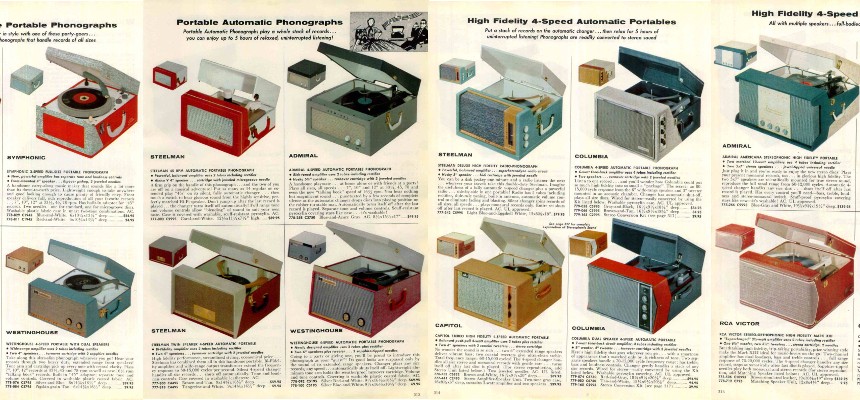A major trend of the postwar era was toward music portability. There were portable phonographs available from the very beginning, and small portable radios were common from the 1940s on. Of course, it depends on how you define “portable.” The “portable” record players of the post-1945 era were usually just smallish models equipped with a handle. You still had to have a wall outlet to plug them into. True portability began with the commercialization of the transistor.
This tiny electronic device replaced the vacuum tube, which sucked down electricity at such a prodigious rate that it demanded large batteries. Small, efficient transistor radios appeared around 1955 and became top sellers, especially after prices came down to the point where young people could own them. Transistor phonographs were available, but they were not as popular as transistor tape recorders. Although their sound quality was pretty lousy, transistor tape recorders became a big hit with teenagers in the U.S. and Europe. People typically used them to re-record music from the radio or from records (their own or their friends’). When the Phillips Company in Europe introduced the Compact Cassette in 1962, it was initially rather expensive (about $75 for a battery-operated “Carry-Corder”).
However, many other manufactures adopted the new tape format, and Asian firms soon introduced cut-rate models. By the end of the 1960s, battery operated portables were by far the best selling form of the tape recorder. The record industry paid little attention to the potential market for tape. Many record companies had introduced recorded reel-to-reel tapes beginning in the early 1950s. Some, like RCA-Victor, promoted both inexpensive home tape recorders and the tapes to play on them. But recorded reel-to-reel tapes were poor sellers compared to the LP, and cost at least a dollar more. The recorded reel-to-reel was an expensive failure for the record industry (although it did find a niche market among high fidelity aficionados). That’s why the success of the 8-track tape was a bit of a surprise. The 8-track system was intended to be heard in the automobile–not surprisingly it was invented in the United States, where the car culture is strong. Home players could also be had, but manufacturers suspected that the tapes would be most appealing to commuters–and they were right. Introduced in 1965 by Ford, the 8-track sold in large numbers in the late 1960s and early 1970s until it took nearly a third of the market for recorded music. Ultimately the 8-track would fail, but it paved the way for music on cassettes.
As cassette technology improved, it graduated from being a child’s toy to being part of the home stereo system. Innovations such as Dolby B noise reduction and “metal” tape were created just for the cassette, and soon it took on the high-tech appeal that the LP had. At the same time, it retained the portability of music. The importance of this combination became clear in 1978 with the introduction of the Walkman tape player, which also combined high fidelity and portability. Along with the “boom box” type of radio/tape player combination, the Walkman (and its imitators) helped the cassette displace the LP as the dominant form of home music technology by about 1990. Record companies began cutting back on their LP releases to concentrate on the cassette, while only the most popular releases were available on LP. The combined effects of the introduction of high fidelity, the booming world economy, and the popularity of rock music stimulated huge growth for the record and electronics industry. The sale of records in the U.S. alone grew from about $600 million in 1960 to $1.2 billion by 1970. While RCA-Victor, Columbia, and EMI thrived, so too did a number of new labels, such as Capitol, Atlantic, Motown, and Elektra. There was also a tendency, beginning in the 1960s, for conglomerates to form that included both motion picture and recording arms, since the two often complemented each other. Sales of music through the mail took off, with Columbia House emerging and the dominant firm in the U.S. By the 1980s, Music Television (MTV) had emerged, linking TV and records through the exhibition of music videos. RCA by the 1980s was floundering, and after it was purchased by General Electric the RCA record division was sold to the German company Bertelsmann.
